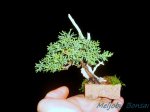bilbocannon
Shohin
I found this deadwood in the backyard when i moved into my current rental property.
What do you think?
As mentioned i think i will try shimpaku, any suggestions for other types of tree are welcome.
The bottom left hand side is snapped off. I was going to re attached im just not sure on which orientation yet.


This squamata tanuki is my inspiration
Which i saw today on ebay.

What do you think?
As mentioned i think i will try shimpaku, any suggestions for other types of tree are welcome.
The bottom left hand side is snapped off. I was going to re attached im just not sure on which orientation yet.


This squamata tanuki is my inspiration
Which i saw today on ebay.




